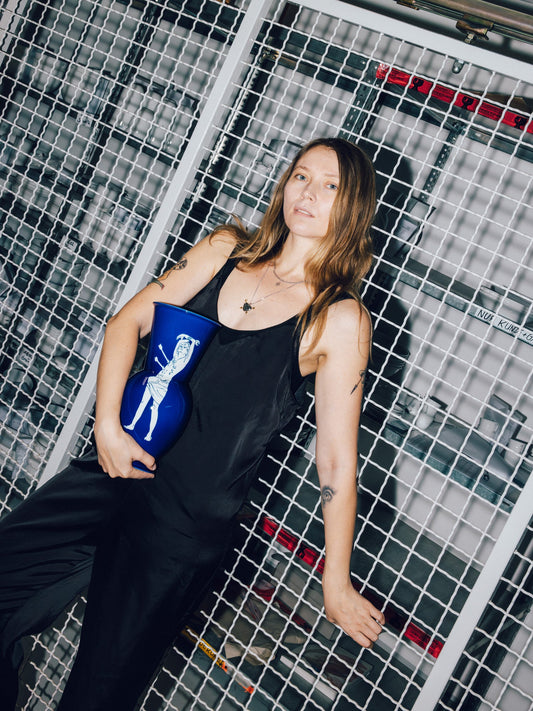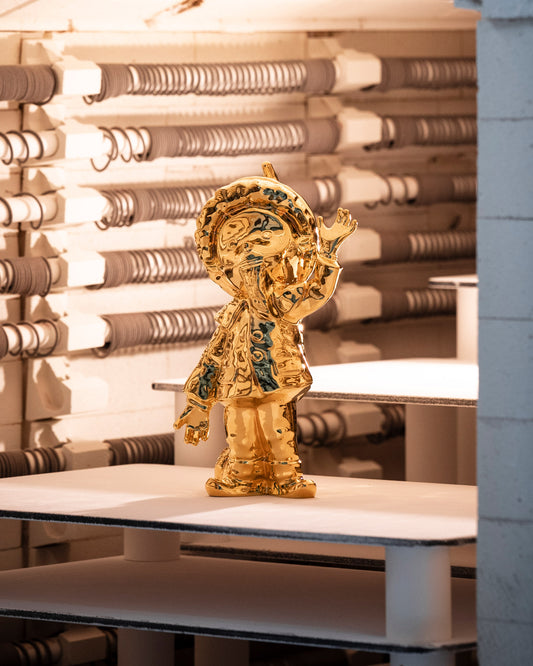INTERVIEW WITH TOM SALLER – AUTHOR OF "A NEW BLUE"
The long tradition of KPM Berlin inspires many stories, and Tom Saller tells a very special one in his second novel "Ein neues blue". We spoke to him about how fiction and reality come together in his work - and also found out which is his favorite piece from our manufactory.
What inspired you to write your new book?
As is so often the case when writing a novel, it is the detour that leads to the goal. Originally, I wanted to write a book about Elly Beinhorn, another strong female figure of the early 20th century. During my research on aviation, I came across the "Hermes" service, which Marguerite Friedlaender had designed for the newly opened restaurant at Halle Airport. I also saw pictures of her famous "aviator cup", the mirrored surface of which is cut out in the lower bowl so that it stands securely during the flight. I was fascinated by the simplicity of the designs and their innovative approach.
What came first? The idea of the story or the setting around KPM Berlin?
Certainly the idea of the story, or rather, its main character, Lili Kuhn. I had her in mind from the beginning. A (half-)Jewish girl who grows up motherless and is raised by her father and two buddies, a Japanese man and a rabbi. I intended to follow Lili into old age, specifically into the 1980s, where she meets the other main character, Anja, 18 years young. The meeting of the two generations appealed to me.
Did you have any points of contact with KPM Berlin before your book?
Only indirectly; I knew that Lili would meet Marguerite Friedlaender in her youth. When I told a good friend, also a writer, that the topic of my new novel was porcelain, he said that he was well acquainted with the director of a Berlin hotel owned by Jörg Woltmann, the owner of KPM. If desired, he could try to establish contact.
KPM Berlin has a very old history. Why is your novel set in the early 20th century?
This is partly due to my previous novel "Wenn Martha tanzt". It takes place to a large extent at the Bauhaus in Weimar, where I had already met Marguerite Friedlaender. During my research on KPM, I came across Günther von Pechmann, who had been appointed director of the manufactory at the end of the 1920s. Both personalities had set themselves the goal of using the spirit of optimism of the 1920s to modernize the rather traditional designs to which the porcelain had been subject up to that point. In addition, von Pechmann had in mind the democratization of porcelain in the sense of high-quality everyday tableware for everyone - exciting, I thought.
What particularly fascinated you during your research on KPM Berlin and the contemporary history of that time?
Especially the personality of Günther von Pechmann, who managed not to be taken in by the Nazis until the end of the 1930s - even though the pressure from outside was great and his wife, like Lili, was also half-Jewish. The Nazis would have loved to see the "Gröfaz" in a row with Frederick the Great, but von Pechmann resisted, so that the KPM was not "in line" for a long time. Instead, the SS ran its own porcelain factory in Munich-Allach from the end of the 1930s.
What have you personally learned or taken away from working on this novel?
What a fantastic and still a little mysterious material porcelain is. The fact that it has a complex history spanning thousands of years, far beyond Europe. And that for a writer on a metaphorical level, the analogy between porcelain production and becoming human is irresistible: An object is formed, takes shape. It is fired and thereby gains strength. It receives a glaze and is suddenly no longer gray and unsightly, but shines in the light of reality. And then the final walk through the fire – only what proves itself in the fire will last.
What fascinates you personally about KPM Berlin?
That it is the oldest surviving craft business on Berlin soil. That many people know Frederick the Great, but don't know that he had such a wonderful relationship with porcelain production. That, in my view, KPM has managed to make the leap into the 21st century without betraying its values. I am particularly fascinated by the people who work there. The people I have had the pleasure of meeting are all passionate about the manufactory.
Do you have a favorite collection or a favorite piece?
Marguerite Friedlaender's ”Halle Form” vases, Trude Petri's “Urbino” service and – newly – the products of the LAB series.
"Ein neues blue" by Tom Saller will be published by List Verlag on August 30, 2019.
A young woman is making her way as a porcelain painter at KPM...
When Lili's mother dies young, her father Jakob takes loving care of her. But it is only when she meets Günther von Pechmann, the director of the Royal Porcelain Manufactory, that she finds her destiny: the world of porcelain. But the National Socialists come to power and Lili has to flee Berlin.
Fifty years later, Lili lives again in Charlottenburg, withdrawn in her house with the Japanese garden. She doesn't talk much about herself and her eventful life. Only 18-year-old Anja, rebellious and contrary, can persuade Lili to open up to her. Little by little, Lili's story unfolds, but Anja also has a secret. What role does the simple porcelain bowl play, which the old woman guards like a treasure?


